As we enter the third calendar year of COVID-19, the world continues to grapple with the social and economic havoc that the pandemic has wrought on communities and individuals around the world. Our most vulnerable populations continue to be the most at risk of dire negative outcomes, and the need for targeted social services continues to rise. At Brookings this past year, we have been researching the impacts of the COVID-19 pandemic, collaborating with other stakeholders around the world, and more broadly exploring the importance of data for achieving outcomes.
We also continue to follow the global impact bonds market, which feeds into the Brookings Global Impact Bonds Database, and produce research outputs, such as our key series on measuring the success of impact bonds. Below we share our research from this year and the trends we have observed in the market.
The impact bonds market
As of January 1, 2022, there are 221 social and development impact bonds in 37 countries around the world, including 21 in low- and middle-income countries (LMICs). The leading sectors globally continue to be social welfare (75) and employment (68), while in LMICs employment (8) and health (6) lead the way (Figure 1).
Figure 1
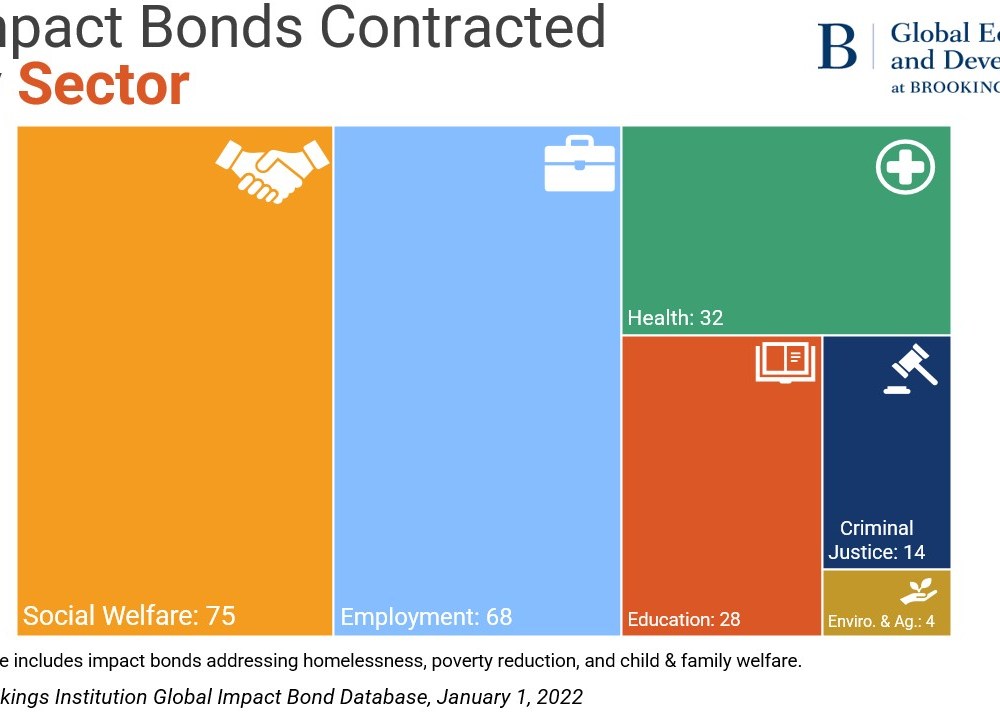
As the world adjusted to the new normal of the pandemic, impact bond projects continued to be launched to address social service needs, though at a slower rate than in years past (Figure 2). This year there was a particular focus on employment—in particular in LMICs such as Colombia and India, which marked their third and fourth new impact bonds, respectively (the most for any LMIC). The India Skills Impact Bond aims to train around 50,000 individuals over the course of the program, with around 1,200 people already enrolled. Additionally, a development impact bond (DIB) specifically targeting economic resilience through entrepreneurship for refugee populations was launched in Jordan and Lebanon.
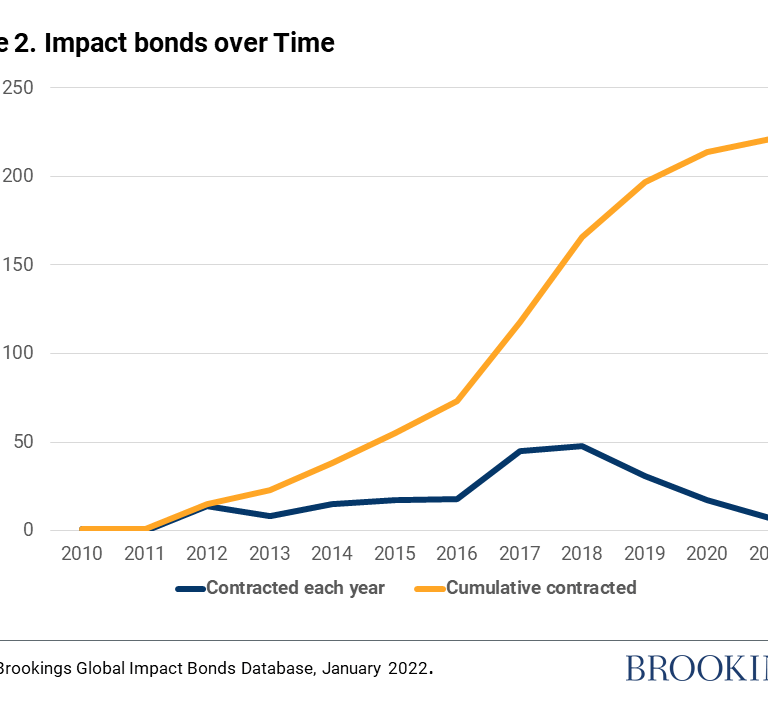
The pandemic and helping vulnerable populations
Much of our research in 2021 focused on the impacts of the COVID-19 pandemic, and the implications for outcomes-based financing. Throughout the year we conducted research on the effects of the pandemic on impact bonds in LMICS, which demonstrated that, in times of crisis, service provision and monitoring and evaluation were flexible to adjustments as needed; however, despite the pandemic, outcome targets were still likely to remain fixed.
We also looked forward to a post-pandemic world and considered impact bonds and outcomes funding as a tool to aid cash-strapped governments in building back better and for curing “social long COVID.” Because complex problems require complex solutions, a focus on outcomes can ensure that multipronged social services programming addresses the many different needs of vulnerable populations as the pandemic rages, and that these populations see meaningful improvement in outcomes.
Collaborating with others
While we have missed gathering in person, a silver lining of our current global crisis is the additional virtual collaboration that has been enabled with colleagues around the world. We were pleased to collaborate with many partners last year on events and research, such as considering the future of partnerships for public purpose with colleagues at the Education Outcomes Fund and exploring the importance of outcomes-based financing for education and the labor market at the Global Steering Group for Impact Investment Summit.
We were also excited to launch our “Voices from the Field” series, which highlights the experiences of those directly involved with impact bond programs around the world. The series kicked off with fantastic contributions on mainstreaming an outcomes mindset with Instiglio and the experience of a pre-K program in the U.S. during the pandemic with the organizations Maycomb Capital and First 8.
Work on data for outcomes
In addition to our research following the global impact bonds market, we delved deeper into the different types of data necessary to achieve outcomes, with a particular focus on outcomes for education. Our research on digital tools for real-time data collection on performance and outcomes will lay the groundwork this spring to create a typology of such tools—and a searchable interactive allowing users to find a tool that fits their organization’s needs.
We have also continued to advance our work on cost data for education and early childhood development (ECD). Improved and expanded access to cost and cost-effectiveness evidence allows for more informed investments given scarce resources and serves as a basis for outcomes pricing for outcomes-based financing projects. We are working to tackle both supply- and demand-side barriers to cost data through the development of an online, user-friendly costing tool for ECD, the Childhood Cost Calculator (C3), its accompanying cost database, and the formation of the Global Education and ECD Costing Consortium (GEECC) in partnership with the ECD Action Network (ECDAN).
What’s next?
In 2022, we are excited for our colleagues’ launch of new outcomes-based financing programs—in particular, the Education Outcomes Fund basic education programs in Ghana and Sierra Leone, and the India Back-to-School Outcomes Fund for Education. In addition, there are some promising developments from Colombia where the highest planning authority in the government has issued a document calling for the adoption of payment by results as a public policy, including a dedicated outcomes fund. This would ensure the sustainability and transcendence of this movement across different elected governments for 2022 and beyond.
We’ll also be following the results from impact bonds that are closing out, such as the Village Enterprise Graduation Model DIB whose final results are expected early this year, and the Quality Education India DIB, which is wrapping up service provision in a few months and is expected to announce results later this year.
We look forward to continuing to share our research and that of our colleagues going forward—please stay tuned to learn more. Later this year, specifically be on the lookout for the public launches of our work on data for outcomes, including our C3 resource and research on digital tools for real-time data collection and analysis in education and ECD.
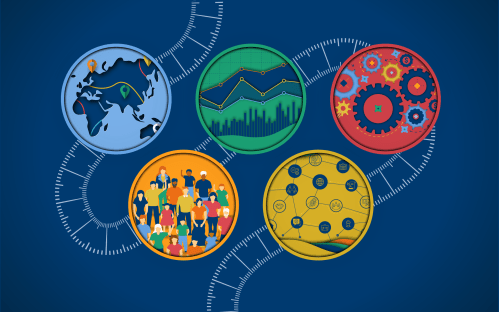

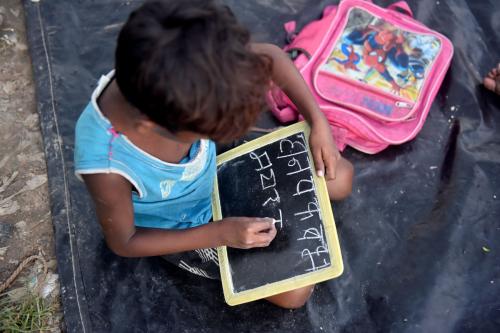

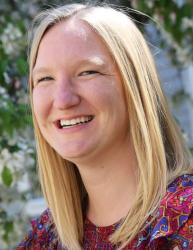



Commentary
A review of the global impact bonds market in 2021 and what to expect in 2022
January 6, 2022